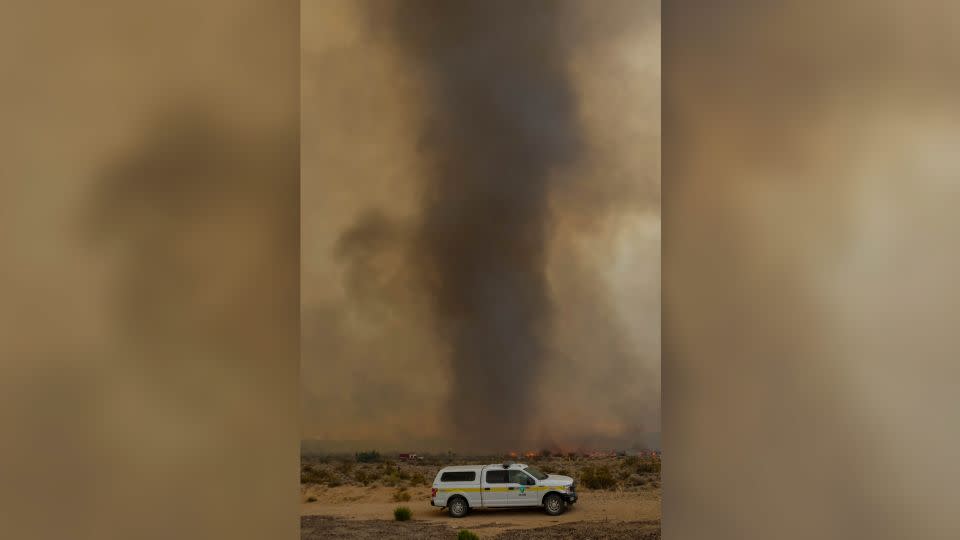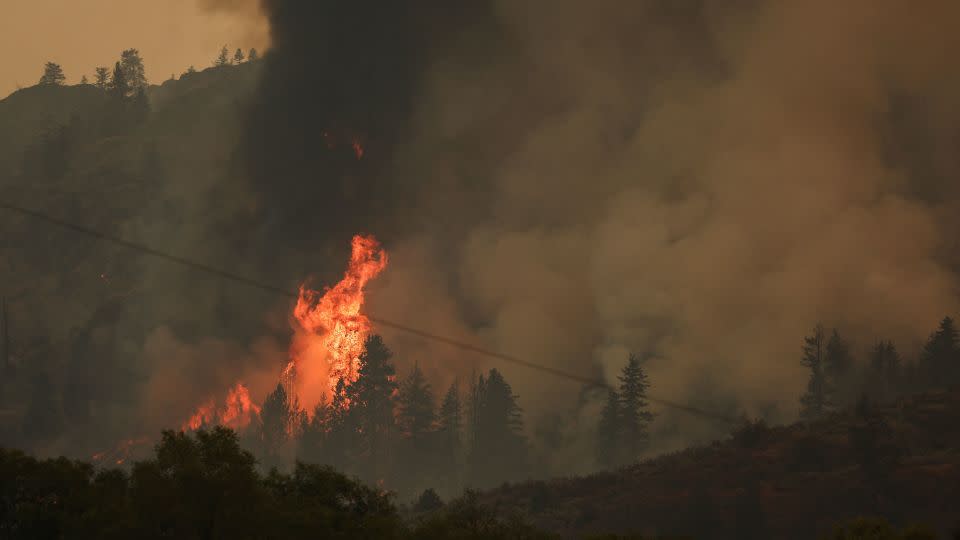Massive fire burning in California and Nevada is spawning dangerous ‘fire whirls’
A massive fire burning across both California and Nevada is generating extreme fire behavior, spawning “fire whirls” and creating dangerous conditions for firefighters, authorities said.
The fire, dubbed the York Fire, which is California’s largest fire of the year, has consumed 80,000 acres as of Tuesday morning. The blaze began Friday in the New York Mountain Range of California’s Mojave National Preserve and crossed state lines into Nevada Sunday as winds picked up under scorching temperatures.
Firefighters were able to gain some control of the fire Monday night and by Tuesday morning the York Fire was 23% contained.
“An infrared flight was completed last night, which provided a better assessment of fire size and activity,” the National Parks Service said on Tuesday.
The blaze is among dozens of wildfires burning around the country as some areas swelter under unrelenting heat – including one fire raging on both sides of the US-Canadian border.
The fire on the California-Nevada state line is still “growing rapidly” and creating extreme conditions that are making it more dangerous and difficult to control, fire officials said Monday night.
Firefighters battling the blaze have seen fire whirls – “a vortex of flames and smoke that forms when intense heat and turbulent winds combine, creating a spinning column of fire,” the Mojave National Preserve said Sunday.
As the fire-heated air rises, cold air dashes to take its place, creating a spinning vortex rising from a fire and carrying aloft smoke, debris, and flame – also referred to as a fire tornado in some cases.

“These fire whirls are similar to dust devils but are specifically associated with the heat and energy released by a wildfire,” the Mojave National Preserve said. “They can range in size from a few feet to several hundred feet in height, and their rotational speed can vary widely.”
Fire whirls can change direction suddenly, making them unpredictable and difficult to anticipate, park service officials said.
Large fire whirls can have the same intensity as a tornado. In 2018, The Carr Fire outside of Redding, California, spawned a fire tornado so destructive that it killed eight people and flattened several homes. The deadly fire had winds over 140 mph, which would equal an EF-3 tornado, or the third most intense tornado on the EF scale.
Crews battling the York Fire are facing sustained temperatures over 100 degrees that are causing difficulties for firefighters, who are increasingly relying on aerial resources.
The struggle to control the York Fire has allowed smoke to reach into Nevada and southern Utah, the fire incident overview noted. There has been “elevated readings for particulate matter” in East Las Vegas, Boulder City and Henderson, according to a tweet from the Clark County, Nevada government.
As hot and dry conditions continue, 64 active large fires are burning across nine states, including 12 large new fires were reported on Sunday, the National Interagency Fire Center said Monday.
More than 11,500 wildland firefighters and other personnel are assigned to incidents throughout the US, the agency said.
As of July 31, 1.1 million acres have burned across the US in 2023, according to the National Interagency Fire Center – still well below the 5.7 million acres that had burned by the end of July in 2022.
Fire on US-Canadian border grows larger

Another large fire burning in northern Washington state keeps growing in size after it crossed the Canadian border from Washington and forced evacuations over the weekend.
The Eagle Bluff Fire has burned thousands of acres on both sides of the border since it ignited Saturday in Washington’s Okanogan County.
High temperatures in the 90s and an expected shift in wind direction on Tuesday will make for what officials are calling a day of “active fire behavior,” which may significantly expand the perimeter of the fire.
On the US side, the fire now spans 15,349 acres with 10% containment, according to a Tuesday morning update. On the Canadian side, the fire has burned over 3,500 acres, according to the British Columbia Wildfire Service.
Evacuation orders were in place Monday for 192 properties in the Canadian town of Osoyoos and areas south of the town within the Regional District of Okanagan-Similkameen, RDOS information officer Erick Thompson said in a Monday press conference.
Another 2,635 properties were under evacuation alerts.
The fire at one point was burning close to an Oroville, Washington, border patrol station.
“The #Oroville #BorderPatrol Station in #SpokanSector had a close call with a wildland fire that reached the outer fence of the property,” the US Border Patrol Spokane Sector said on Facebook. “We are thankful for the wildland firefighters working to protect us and our community.”
Elsewhere, an additional fire ignited Monday afternoon near Spokane, Washington, and quickly sparked mandatory evacuations for at least 20 homes. The West Hallett Fire had already burned 200 acres with no containment by Monday night, according to the Washington State Department of Natural Resources.
The Hayden Fire raging across the Salmon-Challis National Forest 18 miles west of Leadore, Idaho, has burned over 18,000 acres since it started on July 19 and was only 5% contained as of Monday morning, the US Forest Service said in a tweet.
CNN’s Eli Masket, Mary Gilbert, Macie Goldfarb, Joe Sutton, Melissa Alonso, Jared Formanek and Amanda Jackson contributed to this report.
For more CNN news and newsletters create an account at CNN.com

